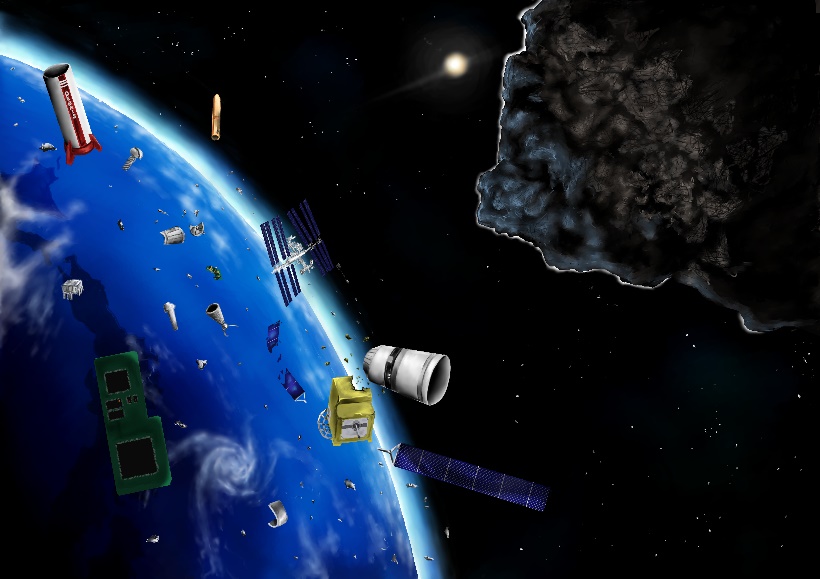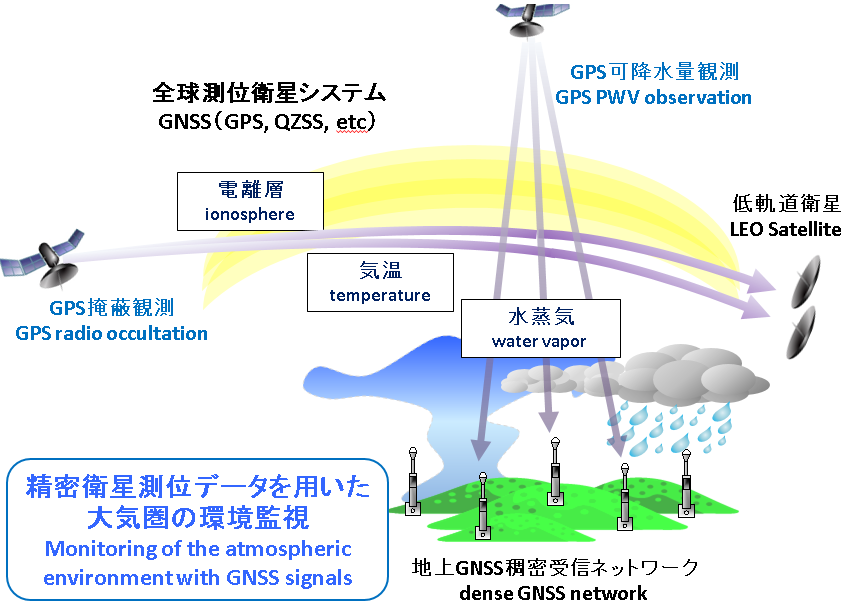2016 Activity Report for Mission 5-3: Space-Atmosphere-Ground Interaction in Daily Life
Updated: 2018/05/18
Research1: Space Debris Observation, Modeling, and Removal
(H. Yamakawa (RISH, Kyoto University); Massimiliano Vasile(Professor,、University of Strathclyde, UK; T. Hanada, H. Fujita (Kyushu University); T. Sato, M. Yamamoto, H. Hashiguchi, K. Hoshi, T. Iwahori, T. Nishimura, N. Ikeda, K. Akari, Y. Kobayashi, R. Araki, T. Teshima (Kyoto University))
overview
Asteroids that are remnants of satellites and rocket bodies have hazardous effects on the maintenance and utilization of space infrastructures for daily life with positioning, observation, and communication functions, as well as endangering the international space station. We are investigating possible general engineering approaches for tackling space debris issues from observation, modeling, and removal points of view.

Research Activities
- Estimation of the size and spin of space debris is an important task in evaluating its trajectory evolution and collision probability with resident objects in space. Profiles of Doppler shifts of known space debris were successfully observed by the MU radar of RISH, Kyoto University, and the size and spin rate of some space debris were successfully estimated.
- Collaborative research on space debris has been done between Prof. M. Vasile’s group of the University of Strathclyde, UK, and Prof. Yamakawa’s group at RISH. The Kyoto group focused on the charging model of space debris in low-Earth orbit, while the Strathclyde group focused on the space debris trajectory simulation, taking the charging effect into account.
- The Lorentz force acts on electrostatically charged objects moving in the Earth’s magnetic field. This implies that charged space debris orbit can be controlled and that debris can be removed by controlling its charge amount. We proposed various charge-control sequences for debris removal and investigated their performance via numerical simulations.
Publications (In Japanese)
- 福島健, 池田成臣, 赤司陽介, 中宮賢樹, 山川宏 “ローレンツ力を用いたスペースデブリ除去のための帯電制御シーケンスに関する研究(Study on Charge Control Sequence for Debris Removal Using Lorentz Force),” 日本航空宇宙学会「航空宇宙技術」Vol. 15, pp. 101-110, 2016.
- 河原淳人、岩堀太紀、山川宏、佐藤亨、山本衛、橋口浩之,”京都大学MUレーダーを用いたスペースデブリの観測手法に関する研究(Study on Space Debris Observation Method Using Kyoto University MU Radar)”,日本航空宇宙学会論文集, Vol. 64, No. 3, pp. 189-199, 2016.
Public Relations (In Japanese)
- 京都大学ホームページ:京都大学MUレーダーで宇宙ごみの姿を捉える、2016年6月6日掲載
- 産経新聞:「宇宙ゴミ」大気レーダーで観測成功…地球周辺の2万個ゴミ、衝突回避・除去に役立つ可能性 京大、2016年6月6日夕刊
- 産経WESTホームページ:「宇宙ゴミ」大気レーダーで観測成功…地球周辺の2万個ゴミ、衝突回避・除去に役立つ可能性 京大、2016年6月6日掲載
- SankeiBizホームページ:「宇宙ゴミ」大気レーダーで観測成功…京大 衝突回避・除去に活用も、2016年6月6日掲載
- 京都新聞:宇宙ごみ 形や大きさ解析 京大グループ 除去につながる成果、2016年6月16日夕刊
- 京都新聞:「超える」⑦宇宙ごみ、小惑星の衝突避ける~京都大学生存圏研究所・山川研究室~探査機ぶつけ地球守る、2017年1月10日朝刊(山城版)
Research2: Ionospheric 3D tomography with GPS
(Mamoru Yamamoto (RISH, Kyoto University), Akinori Saito (Graduate School of Science, Kyoto University), Susumu Saito (Electrical Navigation Research Institute)
overview
We recently started real-time monitoring of ionospheric plasma density distribution over Japan by three-dimensional tomography analysis of GPS total electron content (GPS-TEC) data from GEONET. We are pursuing the extension of the use of the results and are expanding the analysis area by using data from nearby countries.
Research Activities
- Promotion of web publication on tomography results.
By using every-second data from GEONET, we conduct real-time 3D tomography analysis every 15 minutes. We renew web page for data publication for easier use of data. Also, we try to analyze all GEONET data that have been archived since 1996.
- Promotion of the use of data
3D tomography analysis is useful for monitoring the ionosphere over Japan. We will have a brainstorming meeting (planned for March 2017) to extend the data use with participants from research institutions and companies.
- Expansion of the analysis area
A GPS observation network has been developed in nearby countries such as Korea and Taiwan. We will expand the analysis area by adding data from these regions. We will have a workshop to discuss this (planned for March 2017).
Publications, etc.
- (peer-reviewed paper) C. H. Chen, A. Saito, C. H. Lin, M. Yamamoto, S. Suzuki, and G. K. Seemala, Medium-scale traveling ionospheric disturbances by three-dimensional ionospheric GPS tomography, Earth Planet Space, 68:32, DOI 10.1186/s40623-016-0412-6, 2016.
- (peer-reviewed lecture on international symposium) S. Saito, S. Suzuki, M. Yamamoto, C.-H. Chen, A. Saito, Real-time ionosphere monitoring by three-dimensional tomography over Japan, Proceedings of the 29th International Technical Meeting of The Satellite Division of the Institute of Navigation (ION GNSS+ 2016), Portland, Oregon, USA, September 2016, pp. 706-713, 2016.
- (lecture in international symposium) M. Yamamoto, S. Suzuki, S. Saito, C.-H. Chen, A. Saito, and G. Seemala, Realtime three-dimensional tomography of the ionosphere over Japan based on GEONET GPS-TEC, Beacon Satellite Symposium 2016, Trieste, Italy, June 27, 2016.
- Real-time ionospheric 3D tomography by ENRI
- (Reference) GNSS continuous observation system by GSI(GEONET)
Research3: Monitoring of the atmospheric environment with GNSS signals (Toshitaka Tsuda, Masanori Yabuki)

The radio waves transmitted from a global positioning system (GPS) are delayed and refracted by the Earth’s atmosphere. Measurement of the propagation phase delay of GPS radio waves enables us to estimate atmospheric temperature and humidity, which are key parameters for understanding localized torrential rainfall and climate change.
Publications, etc.
Noersomadi and T. Tsuda, Global distribution of vertical wavenumber spectra in the lower stratosphere observed using high-vertical-resolution temperature profiles from COSMIC GPS radio occultation, Ann. Geophys., 34, 203-213, 2016.


